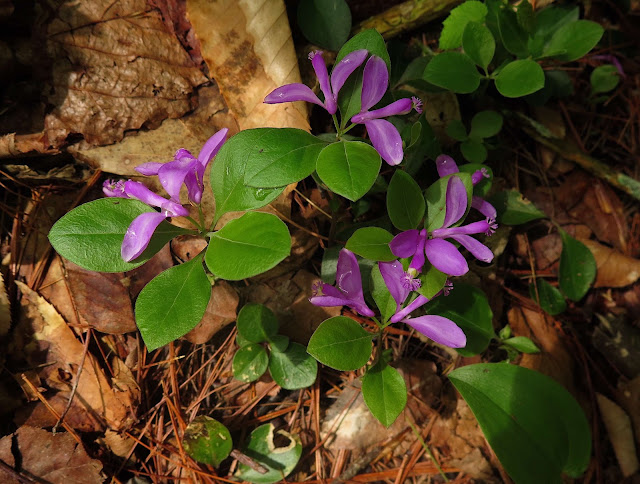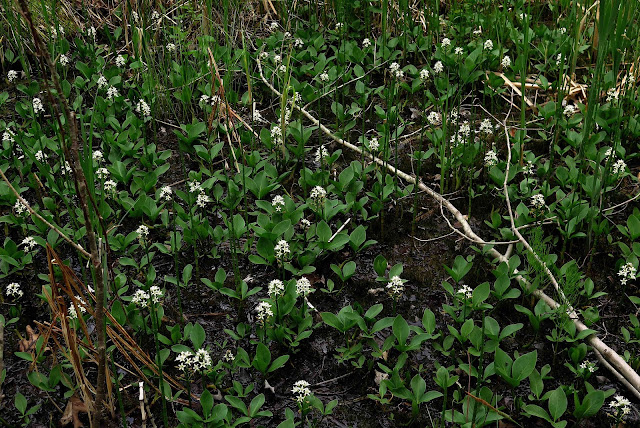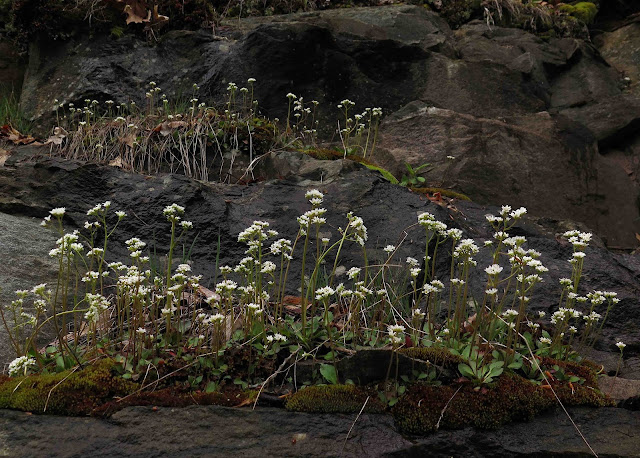Most years, my friends in our Thursday Naturalist group like to walk the Bog Meadow Brook Nature Trail to visit some special flowers that flourish there. Since I volunteered to lead our visit this year, I checked out my many past blog posts that feature this trail, to determine what would be a good date for this year's walk. It appeared that late May would be best. So May 25 is the date we will visit Bog Meadow. But I went there last week, just to see if I could find our targeted flowers in bud. Well, I found the flowers all right. But they were already blooming, not just in bud.
We'll begin our walk from the Rte. 29 trailhead, on the eastern edge of the city of Saratoga Springs. The trail from here runs eastward through wooded wetland, with open water to the north and forested swamp stretching south as far as the eye can see. Diligent and dedicated trail stewards do their darnedest to keep this trail dry enough to walk on without high boots, since the beavers who occupy the trailside water often do their darnedest to flood it. So far, so good this spring. Just a few shallow puddles cross the trail for now.
I was delighted to find many sprouting Canada Lily plants (Lilium canadense) in the trailside grass. And hopeful, too, that these baby plants might live long enough to produce their whorls of gorgeous flowers by early July. In past years, Scarlet Lily Beetle larvae ate most maturing plants down to the ground, but today I found not a single beetle among them. Perhaps a predator wasp has found the devourers of this lily population. Here's hoping!
What a surprise, to still find many spore-bearing stalks of Field Horsetail (Equisetum arvense), along with the spiky green sterile plants that will persist throughout the growing season. I had thought these tan-colored spore stalks would have withered away by now, since it's been nearly a month since I found the first evidence of them. This species of horsetail is quite rampant all along the trail, but despite its abundance, it never seems to overwhelm the other native plants that make their home here.
The swampy verge along this stretch of trail holds many hummocks of Tussock Sedge (Carex stricta), each one an exploding mass of cinnamon-brown bloom at present.
Patches of bright-white tiny blooms of Grove Sandwort (Moehringia lateriflora) spangle the trailside grass. This is not a rare species in our state, but I rarely find it anywhere but here.
I found only a few occasional blooms of Wild Geranium (Geranium maculatum) open yet, but I know these showy purple flowers will be far more abundant by the time my Thursday friends walk here.
And here are the flowers I had hoped to present as the stars of our visit on May25, the beautiful but often overlooked Nodding Trillium (Trillium cernuum). Not only do the flowers hide beneath the trio of their own wide green leaves, but the plants themselves often hide very well beneath the trailside shrubs and overarching Skunk Cabbage leaves. I had hoped that these unusual trilliums would be the feature attraction of our Thursday Naturalist walk, so I hope at least a few nice blooms might persist until then.

I gently pushed a plant back to reveal the lovely, snow-white Nodding Trillium flowers. This species can be distinguished from the whitish form of Red Trillium (
T. erectum) by a number of traits: the sharply reflexed petals and nodding habit of the flowers, as well as the white ovary and the longish filaments of the darker-colored anthers. Red Trillium's ovary is always red, and its anthers are sessile to it. Also, Nodding Trillium's petals are a pure white, not the yellowish or ivory tint of the white-form Red Trillium's flowers. But sometimes the two species hybridize, and then the color variations can get really confusing! Check out my
blog post from 2019 to see some of them!

Here's another lovely flowering plant I hope will still be bearing blooms in a week or so. Again, these are flowers that often stay hidden beneath the plant's overarching leaves. This is Rose Twisted-Stalk (Streptopus lanceolatus), a species much more common in the Adirondacks to the north. I know of only two plants that grow along the entire two-mile length of Bog Meadow Brook Nature Trail.
Since some of us in our Thursday group might find it difficult to get down on their knees and up again, I painfully did it for them, in order to photograph the lovely pink flowers that dangle on twisted or bent pedicels.
I got even lower to photograph the inside of a dainty rose-spotted floret. And it looks as if a dainty white creature (spider or insect?) was sheltering within it!
These pretty pink-tinged flowers were growing on shrubs along this section of the trail. I am almost certain that they are chokeberry blooms (Aronia sp.), and because of their woolly flower stalks and the longish shape of their non-glandular calyx lobes, I am guessing they are the flowers of Purple Chokeberry (A. prunifolia).
The next section of Bog Meadow Trail follows the shore of a marsh, where the birders in our group might hope to see waterfowl swimming on the open water. And I will point out that here is our opportunity to closely observe a Poison Sumac tree (Toxicodendron vernix, pictured here) without wading knee-deep in a swamp or coming into contact with the tree's rash-producing toxins.
The leaves and flower clusters of Poison Sumac were just emerging on my visit. The loosely-spaced flower clusters will lengthen by the time they bloom with greenish-white petals. Late into the fall, the dangling clusters of whitish berries provide valuable food for birds.
In places along the open marsh, the grassy verge is virtually carpeted with the dainty blue flowers of Dog Violet (Viola labradorica), a small, stemmed violet with a pale center.
Here's another very generous spreader, the beautiful Starry False Solomon's Seal (Maianthemum stellatum), sporting clusters of star-shaped white flowers atop gracefully arching green-leaved stalks. It was more than a dozen years ago I first encountered these plants, maybe ten of them, clustered about the foot of a large White Pine. Today, I stopped counting them after a hundred, spread some distance along the trail from where I first found them.

Finally, I enter a deeply shaded section of the trail, a little over a half-mile from where I started. I hope our Naturalist friends will be willing to proceed about a quarter mile further through this woodsy and watery habitat before we turn around. A mile-and-a-half is a long way for us botanizers to explore, inching along at the super-slow pace we usually accomplish in wildflower-rich settings like this. Flower-heavy limbs of Highbush Blueberry (Vaccinium corymbosum) reach onto the trail in this section, and I wonder why here but not along other parts of the trail.
There were several bees feeding on these blueberry flowers, some of them chewing straight to the nectar source by cutting into the flowers. At least this big bee with the shiny abdomen (a Carpenter Bee?) appeared to be entering the flower by its usual entrance.
Like the stars in the sky, the seven-pointed, bright-white blooms of Starflower (Lysimachia borealis) appear at their most stunning in the dark, in this case the deeply shaded, needle-strewn forest floor under pines.
Near a partial clearing where the sun's rays made it through the dense tree canopy, I found a sprawling shrub of Round-leaved Gooseberry (Ribes rotundifolium) dangling numerous flowers with stamens that protruded well beyond the sepals.
When I reached a section of the trail where shaded trailside pools were broad enough to reflect the sky's light, I began to search for Bog Buckbean (
Menyanthes trifoliata). In some years, I'm lucky to find only a few specimens protruding from the shallow water. But this year, Bog Buckbean's white flower clusters that crown three-leaved green plants were massed so closely together and in such numbers, I could hardly detect the water beneath them.
Such beautiful and interesting flowers, like five-pointed stars, each petal sprouting squiggly, wiry growths unlike anything I have seen in any other flower.
There was one more flower I hope to find before the turn-around point, and luckily this Perfoliate Bellwort (Uvularia perfoliata) was just coming into bloom. I saw many emerging plants, but only a couple that were dangling the long-pointed yellow flowers with stems that appeared to be piercing the leaves. By May 25, the whole patch should be dangling these flowers, and that will make them easy to find.
At first glance, the Perfoliate Bellwort looks very much like the related Large-flowered Bellwort. But side from the difference in size between the two species, the certain most distinguishing feature of Perfoliate Bellwort is the presence of tiny glandular bumps on the interior surface of the petals. They are often of a deeper yellow or orange than the petal.
After turning around, I began to hurry my steps as a few raindrops tickled my face. But I'm glad that was it, for a rainstorm, since I quickly drew to a halt when I spotted this pink-budded, white-blossomed small tree some ways back in the trailside woods. I grew up playing in my grandpa's apple orchard. Sure looked like an apple tree.
Well, the multiple pistils were a sure indication of a multi-seeded fruit. So probably an apple. Maybe a crabapple. Perhaps a bird pooped a crabapple seed. Or a hiker tossed an apple core. Not a native woodland tree, but it sure was a pretty one.
Two gorgeous native woody plants do grow in this stretch of the trail, but I did not find them on this walk. It's likely neither was blooming on this day, but here's hoping they will be on May 25. I'd love to show my friends the confetti-colored flowers of a Glaucous Honeysuckle (Lonicera dioica), one of several honeysuckle vines that are native to this region. And it grows along Bog Meadow Brook Nature Trail. And it's a real beauty!
Even more, I'd love to have my friends see -- and smell -- this gorgeous Early Azalea (Rhododendron prinophyllum) that grows in the Bog Meadow woods. Quite a ways back in the woods, so I'd need to spy its vivid pink flowers in order to find it. Usually, if the air is warm and humid, I can detect its nearby presence by the exquisite fragrance that wafts on the air.
I am going to share this post with the Thursday Naturalists, so they will know what to look for when we walk together next Thursday. Yes, some flowers may be past bloom by then, but other beauties will take their place. No walk with these friends or along this trail is ever not wonderful.































































